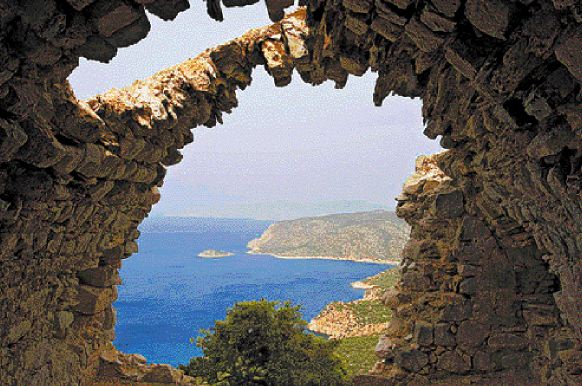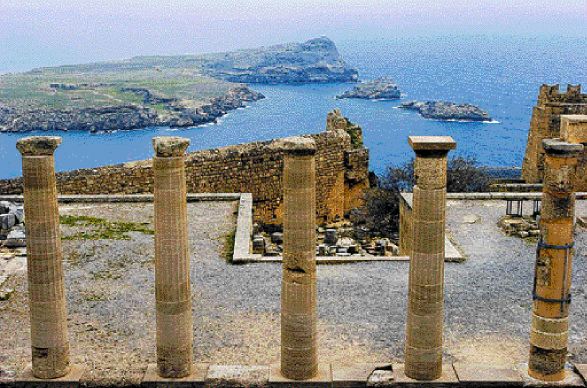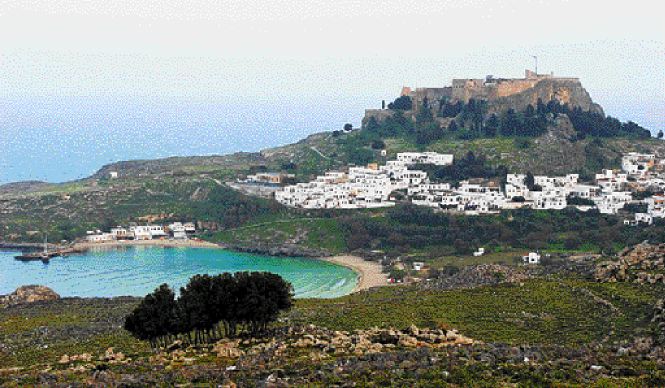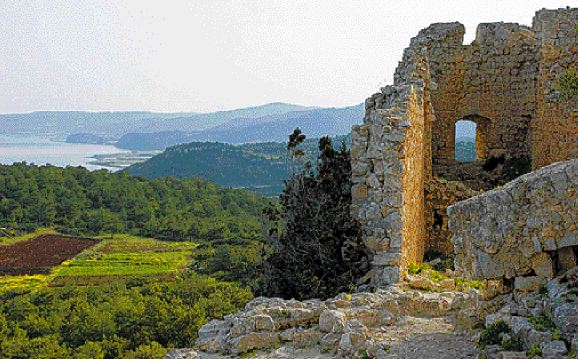|
|
Rhodes off the beaten track
|
The Island of the Knights boasts a treasury of
castles and natural beautiesfor the inquisitive
traveller who wishes to venture beyond the
old town
By Dione Dodis
Athens News
|
Dawn broke just as our ship was entering the commercial harbour of the town of Rhodes. We stood at the prow to get a better view of the magnificent scenery unfolding in front of our eyes. The first sun rays hit the ramparts, the castles and turrets of the old city, colouring them with a rosy hue. Behind us, in the distance, the coast of Turkey was shrouded in clouds. As we inched our way into the harbour we passed the rounded sandstone Fort of St Nicholas, built at the far end of the Windmill Mole, which separates the main harbour from the smaller one, the Mandraki. No colossus was standing on the site of Fort St Nicholas watching the harbour with its legs astride the mouth so that ships would pass underneath. Actually, the precise site where the Colossus stood has never been determined with accuracy. We only know that the Rhodeans commissioned the sculptor Chares of Lindos to execute an immense bronze statue of the sun god Helios from the spoils left by Demetrius Poliorcetes when he raised the siege of the city. The finished statue stood 31m high and was considered one of the Seven Wonders of the World. The great earthquake of 227BC ruined the town and the statue alike. For nine centuries the figure of the sun god was lying shattered where it fell until the Persian raider Moabiah had the metal transported in camel loads to Syria.
|
At the centre of the quay, where the ship docked, the massive Marine Gate stands between two round towers with overhanging battlements. It is one of several gates that lead into the mediaeval city through the thick, impenetrable walls. As early as the sixth century AD the Byzantines had fortified the city with heavy ramparts and turrets to protect it from invasions of Saracens, Venetians and Genoese, all of them after the lucrative trade of the island. Little is visible today of the Byzantine walls as the Knights of St John, when they took over the island in 1309, built over them much taller and wider fortifications. Four kilometres in length, these walls encircle the old city and are surrounded by a moat, forming an outer circle. There is a walkway on top of the scarped wall at the southern side of the old town, from the Gate of the Cannons until the Gate of Koskinou. It gives you an overview of the mediaeval town on the one side and the modern city on the other. We entered the walled city from the Gate d'Amboise where the moat is at its widest. |
 Looking down from the precipitous
Looking down from the precipitous
rock of Monolithos
|
Nowadays it is landscaped into a beautiful park with a mixture of trees - cypresses, palms and olive trees - and a great variety of flowers. To the north-west is the so-called Collachium, or Castle, which in mediaeval times was divided from the remainder of the old town by an inner wall, like a city within a city. The Collachium was the exclusive preserve of the Knights of St John who were not permitted to go into the rest of the town unless they were on horseback, or walking two and two. Grey stone buildings, castles, palaces and churches adorn the abode of the knights, all of heavy Gothic architecture, quite alien to the gentle island landscape.
|
 The columns of Propylaia at Lindos'
The columns of Propylaia at Lindos'
Acropolis
|
After a tour around the magnificent Collachium we decided to get out of the city to visit the three main castles of the knights and, at the same time, to savour the delightful Rhodean countryside. On our way westwards we stopped to visit Mount Agios Stefanos, or Monte Smith, a low hill on the outskirts of the city. On top of the ridge are the ruins of the ancient acropolis, at a lower level there is a temple of Phythian Apollo and further down the gentle slope, among the olive groves, a stadium and a small theatre. It is an attractive spot and makes for a pleasant walk for the townspeople. We then took the wide road that leads to Philerimos, stopping briefly at Trianda to admire the outstanding early 16th-century frescoes in the church of Agios Nicolaos and Agia Aikaterini. Soon, the flat-topped mountain of Philerimos came into view. It was the site, in antiquity, of the city-state of Ialysos, one of the three Rhodean cities mentioned by Homer - Ialysos, Kameiros and Lindos. No traces of the ancient acropolis remain, apart from some scattered column drums. |
Later, a Byzantine fortress had been constructed on the mount and a Christian basilica was built over the ancient temple of Athena Ialysia. The sanctuary of this church was subsequently adapted as the entrance to a mediaeval successor, Our Lady of Philerimos, built to house the miraculous icon of the Virgin. The knights had a strong castle built there to protect the famous church and a monastery next to it. Fierce battles took place for the conquest of this strategically placed castle between the Byzantines and the knights and, later, the Turks. In spite of its turbulent history, the place has a serene and tranquil atmosphere. In the old days, in moments of trouble, the icon of the Virgin, the patron saint of the island, was carried in a solemn procession to Rhodes and then through all the main streets of the town. Naturally, they did this during the last great siege of the Turks but to no avail. What we see now in the church of our Lady of Philerimos is a copy of the famous icon. It is a striking image of the Virgin, something I shall never forget. But it has long since vanished. The knights, when they abandoned the island, took the venerated icon with them to Malta. Later, she travelled to Russia with the last grand master and her traces were lost.
We continued on the main road towards Monolithos. We passed the ruins of the ancient city of Kameiros and the dark, craggy slopes of Atabyron, the chief mountain of the island, and took the steep, winding road that leads to the fortress, one of the three main castles of the knights - Monolithos, Pharaclos and Lindos. Situated on the top of a precipitous rock called Monopetra and accessible only by a single, narrow path, Monolithos is the most spectacular castle in Rhodes. The rough climb to the top where the Byzantine church of Agios Pantaleonos still stands, is well worth the effort. The views of the mountainous interior of the island, on the one side, and the deep blue Aegean on the other, are magnificent.
We crossed the island from the west to the eastern flat coastal belt. Nearing Lindos, the landscape changed abruptly to a huge outcrop of rock, 116 metres above sea level, at the top of which the ancient acropolis of Lindos was built in the 10th century BC. The geographical position of the fort, between two goods harbours, with access to eastern trade routes, led to Lindos becoming the most important of the three ancient city-states of Rhodes. A small temple of Lindian Athena stands at the edge of the cliff at the southern point of the acropolis. In the Byzantine period, the acropolis was turned into a fortress which the Knights of St John later made into the headquarters of a Castellany. Peering down from the steep, northeastern edge of the cliff, we could see the two blue circles of the harbours - the smaller one where popular tradition says that St Paul was shipwrecked and the larger one where Cleobulos, the ancient tyrant, lies buried. The huddled village that lies at the foot of the acropolis is of a scrupulous Aegean order. The narrow streets, paved with clean sea-pebbles, are criss-crossed with little inter-communicating alleys. Their width is enough to accommodate two donkeys abreast but no car can enter. The houses are whitewashed and so are the little chapels waiting for you around every corner. Near the main village square, where the donkey stand is, stands the church of the Panagia. Bearing the dates 1484-90, as well as the arms of d'Aubusson, it has the form of a Latin cross and is decorated with the most amazing frescoes.
On the way back to the town of Rhodes the road passes two more great castles of the eastern coast. One is the spectacular castle of Archangelos, built in 1467 by Grand Master Orsini, the other the immense castle of Pharaclos, one of the strongest built by the knights and thus the last to fall to the Turks. Since the fall of Constantinople in 1453, the Knights of Rhodes knew their turn would soon come. Thrown on the defensive, they lived perpetually on the alert. Grand Master Pierre d'Aubusson strengthened the city walls and the three chief castles - Lindos, Monolithos and Pharaclos - as well as the castles of Kos and Halicarnassos. Indeed, in 1480, the first great siege took place.
|
Sultan Muhammad II fitted out a large fleet and, in order to detach the Rhodean Greeks from their allegiance to the knights, he entrusted the chief command of the invading forces to Emmanuel Paleologos, son of the last despot of Morea and nephew of the last emperor of Constantinople. In spite of the many privileges he showered on the civilians, the Rhodeans fought bravely on the side of the knights. As soon as the Ottoman fleet left the harbour of Marmarice, on mainland Turkey, the country folk took shelter in the city and castles, bringing their household goods with them. Naturally, they also transported the miraculous icon of the Virgin from Philerimos to St Mark's church in town. During the three months of the siege, fierce battles took place at various points around the fortified city of Rhodes, Fort St Nicholas being the point most seriously attacked. Having suffered great losses, the Turks broke the siege in August, 1480.
|
 A panoramic view of Lindos' Acropolis and Village
A panoramic view of Lindos' Acropolis and Village
|
Some 40 years later, in 1522, the second great siege took place. By now Egypt had been conquered by the Ottomans and the expulsion of the knights from Rhodes was imperative because of the position of the island on the line of communications between Constantinople and Alexandria. This time it was Suleiman the Magnificent who prepared the attack and Grand Master Villiers l'Isle Adam who undertook the defence. The Turkish fleet numbered 300 ships and the invading army 200,000 men. As in the first siege, the fleet crossed the straits from Marmarice and started heavy bombardment of the city. But this time around they captured the fort of Philerimos to stop reinforcements coming to the aid of the knights from the west. One after another the city walls were breached at strategic points, with immediate assaults following. The sultan had posted himself on a watch tower made of ships' masts and, like Xerxes at the naval battle of Salamis, he was witnessing the battle from a vantage point.
|

A view from the castle of alysos, one of the three
ancient cities of Rhodes and the first placed
fortified by the Knights of St. John
|
The knights sustained this great onslaught with remarkable bravery for six months. They capitulated only when their supplies were completely exhausted. The Ottomans had the great advantage that they could easily bring in reinforcements and supplies. On 20 December 1522 the capitulation was signed. Suleiman, in homage to their heroism, offered the knights the best possible terms - that after the evacuation of the city of Rhodes and of the castles they could sail to Crete in Turkish ships, free of charge, taking with them their arms and all their possessions. Furthermore, any civilians wishing to leave Rhodes could follow the knights with all their belongings. Nearly all the country folk remained but about half the citizens sailed away with the knights.
|
Once again the Knights of St John were homeless and roaming around Europe in search of a permanent home until, finally, in 1530, they established themselves in Malta, having been given this land as a fiefdom by Charles V. As for the Rhodeans, they had to endure long years of foreign occupation, four centuries under the Ottoman Turks and 30 years under the Italians, until they could become part of the Hellenic world again.
Photos by Marina Dodis
|
(Posting date 24 April 2006; reformatted February 2007)
HCS readers can view other excellent articles by the Athens News writers and staff in many sections of our extensive, permanent archives, especially our News & Issues, Travel in Greece, Business, and Food, Recipes & Garden sections at the URL http://www.helleniccomserve.com./contents.html
. Readers enjoying these articles may wish to subscribe to the Athens News by visiting the website and following online directions at http://www.athensnews.gr.
All articles of Athens News appearing on HCS have been reprinted with permission.
|
|
|
|
|
2000 © Hellenic Communication Service, L.L.C. All Rights Reserved.
http://www.HellenicComServe.com
|






